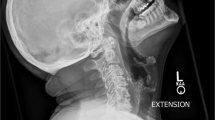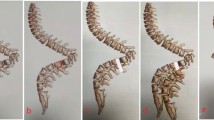Abstract
Study design:
We report a successful extensive transoral anterior decompression for an elderly patient with myelopathy and occipitalgia due to severe atlantoaxial vertical subluxation and posterior subluxation of the axis associated with rheumatoid arthritis (RA).
Objective:
To describe the treatment of an exceptional pathological condition involving severe vertical subluxation.
Setting:
University-affiliated hospital in Gifu, Japan.
Methods:
A 73-year-old woman was referred to our clinic because of myelopathy and occipitalgia due to severe atlantoaxial vertical subluxation and posterior subluxation of the axis associated with RA. Plain radiographs revealed severe atlantoaxial vertical subluxation and sagittal magnetic resonance (MR) imaging revealed severe compression of the spinal cord at the level of the C2/3 disc space due to both posterior subluxation of C2 and rheumatoid pannus at the C2/3 disc space. As MR images demonstrated that the C2/3 disc space was located just behind the retropharyngeal wall, we performed successful anterior decompression from C2 to C3 via the standard transoral approach without mandibular osteotomy.
Results:
The patient has been followed for 4 years and her symptoms are currently much improved without further surgical treatment.
Conclusions:
The present case illustrates that severe atlantoaxial vertical subluxation and posterior subluxation of the axis associated with RA can be treated successfully by anterior decompression of C2 and C3 via the standard transoral approach.
Similar content being viewed by others
Introduction
The transoral approach can be used for exposure of the odontoid process and upper cervical vertebrae.1, 2, 3, 4, 5, 6 In addition, a self-retaining Crockard retractor, which spreads the upper and lower jaws sufficiently and displaces the tongue effectively, has greatly simplified this approach from a technical perspective.3, 4 However, access to the C2–C3 disc space and the vertebral body of C3 generally requires mandibular osteotomy.1, 2, 5, 6, 7, 8, 9, 10, 11 In this article, we report a case of severe atlantoaxial vertical subluxation and posterior subluxation of the axis associated with rheumatoid arthritis (RA). The patient was treated successfully by anterior decompression from C2 to C3 via the standard transoral approach. The vertical subluxation in this patient was so severe that the conventional transoral approach was able to provide sufficient surgical exposure of C2 and C3.
Case report
A 73-year-old woman presented with severe myelopathy and occipitalgia. She had grade IV, class 4 RA and had been suffering from RA for 35 years. Due to multiple joint involvement, she had been experiencing difficulty with walking for almost 1 year, but was able to stand unaided. However, 7 months prior to presentation, she had become unable to stand or use her hands in her daily activities, including feeding herself, because of progression of the myelopathy. Furthermore, she could not maintain a sitting or standing position due to severe occipitalgia. Deep tendon reflexes in her upper and lower extremities were exaggerated bilaterally. Neurological examinations revealed marked loss of both motor and sensory function below the C4 level.
Plain cervical radiography in lateral view showed severe atlantoaxial vertical subluxation, erosion of the odontoid tip, intervertebral fusion from C3 to C5, and severe osteoporosis (Figure 1). Sagittally reconstructed 3D-CT images indicated that the odontoid process had been degraded by osteolysis (Figure 2). Sagittal magnetic resonance imaging revealed severe compression of the spinal cord at the level of the C2/3 disc space anteriorly by both posterior subluxation of C2 and rheumatoid pannus at the C2/3 disc space and posteriorly by thickening of the ligamentum flavum in the C2/3 interspace (Figure 3). However, the anterior aspect of the medulla oblongata was only slightly compressed. We considered that both anterior decompression and posterior decompression and fusion would be necessary for the patient. However, taking her general condition into account, we considered that a one-stage anterior and posterior operation would be excessively stressful for her. Therefore, we chose a two-stage operation involving anterior decompression and fusion for the first stage and posterior decompression and fusion for the second stage. As magnetic resonance (MR) images demonstrated that the C2/3 disc space was located just behind the retropharyngeal wall (Figure 3), we decided that the transoral approach would provide sufficient exposure of C2 and C3 for the first anterior operation.
Surgical procedure
The interdental distance was 40 mm at maximum bite opening under general anesthesia. The patient was placed in the supine position and the head was secured with a Mayfield clamp. A low-profile, self-retaining Crockard retractor system (Codman, Randolph, MA, USA)5 was used for mouth opening, and a tongue depressor was placed in position with its handle elevated and fixed to the mouth gag.5 After retracting the tongue inferiorly and incising the midline of the retropharyngeal wall, we were able to approach the anterior aspect of the C2 and C3 vertebral bodies. Then, resection of C2 and C3 was performed using a high-speed air drill. The rheumatoid pannus at the C2/3 disc space was removed completely. Finally, sufficient decompression of the dura mater was observed, and an iliac bone graft was placed during manipulated traction.12
Immediately after the operation, the patient showed improvement of occipitalgia and became able to maintain a sitting posture. Magnetic resonance imaging (MRI) revealed sufficient anterior decompression at the C2/3 level (Figure 4), although the spinal cord was still compressed posteriorly at the C2/3 segment due to hyperlordotic curvature. Despite slight hypesthesia in the upper and lower extremities, the patient was satisfied with the outcome, and therefore the second posterior operation was cancelled. At 5 years after the operation, plain cervical radiography in lateral view indicated that bony union was completed (Figure 5). The patient was able to maintain a standing posture and walk using a walking frame. As vertical subluxation has not worsened and there are no symptoms related to the medulla oblongata, the patient is currently being followed up without further surgical treatment.
Discussion
The transoral approach provides direct midline access to the ventral craniovertebral junction, which is necessary for decompression of the lower brainstem and upper cervical spinal cord.1, 2, 3, 6, 10, 15 This approach can be classified into three types. First, the transoral–transpalatal approach alone usually provides access to the middle and lower clivus.13 Second, the standard transoral approach (transoral–transpharyngeal approach) provides access from the lower third of the clivus to C2.2, 8, 9, 10 Third, the transmandibular approach with split1, 2, 6, 8, 9, 10 or bilateral sagittal split7 mandibular osteotomy provides access down to the C5 vertebra, although this osteotomy increases the invasiveness of the surgery.
Possible indications for a conventional transcervical approach to the upper cervical spine and clivus have been described,10, 14 although Atul et al15 reported that this approach made it more difficult to access the upper cervical spine than the subaxial region. Furthermore, the transcervical approach becomes more technically demanding when it is used to attempt interbody fusion in the upper cervical spine.15 Although there is no general agreement as to which approach is best for fusion surgery at the C2/3 level, the relative geometry of the mandible and the C2/3 vertebrae on lateral cervical films might provide surgeons with some helpful clues.15
In the present case, atlantoaxial vertical subluxation, posterior subluxation of the axis, and formation of rheumatoid pannus at the C2/3 level severely compressed the spinal cord and resulted in neurological deficits, as is sometimes observed in patients with RA.3, 4, 6 Therefore, the present patient required extensive anterior decompression of C2 and C3, for which the transoral approach alone without mandibular osteotomy provided sufficient exposure. This was confirmed preoperatively, as MRI revealed a peculiar geometric relationship between the retropharyngeal wall and the C2–3 disc space. MR images should be carefully evaluated preoperatively during surgical planning for treatment of upper cervical spinal disorders in patients with RA.
In the present patient, although postoperative MRI still demonstrated a moderate indentation posteriorly and the neurological status of the patient had not recovered completely, the patient herself was satisfied with the outcome mainly because of the pain relief she experienced. Besides the successful application of this approach for accessing the C2/3 disc space, the present case is also noteworthy because of the acceptable outcome that was achieved by a single anterior decompression procedure via the transoral approach.11 This approach can be applied for patients with severe vertical subluxation whose general condition is relatively poor.11 However, if we take into account the complexity of the transoral procedure and the hyperlordotic curvature at the upper cervical spine in the present patient, posterior decompression and fusion may also have been effective, depending on the surgeon's choice.
Conclusion
Atlantoaxial vertical subluxation and posterior subluxation of the axis in patients with RA can be treated successfully by anterior decompression for C2 and C3 via the standard transoral approach.
References
Apostolides PJ, Vishteh AG, Sonntag KH . Technique of transoral odontoidectomy. In: Sonntag KH (ed). Operative Techniques in Nuerosurgery. Vol 1. WB Saunders: Philadelphia 1998, pp 58–62.
Arbit E, Patterson RH . Combined transoral and median labiomandibular glossotomy approach to the upper cervical spine. Neurosurgery 1981; 8: 672–674.
Crockard HA . The transoral approach to the base of the brain and upper cervical cord. Ann R Coll Surg Engl 1985; 67: 321–325.
Crockard HA, Johnston F . Development of transoral approaches to lesions of the skull base and craniocervical junction. Neurosurg Quart 1993; 3: 61–82.
Crockard HA . Transoral surgery: some lessons learned. Br J Neurosurg 1995; 9: 283–293.
Shaha AR, Johnson R, Miller J, Milhorat T . Transoral–transpharyngeal approach to the upper cervical vertebrae. Am J Surg 1993; 166: 336–340.
Vishteh AG et al. Bilateral sagittal split mandibular osteotomies as an adjunct to the transoral approach to the anterior craniovertebral junction. J Neurosurg 1999; 90: 267–270.
Hall JE, Denis F, Murray J . Exposure of the upper cervical spine for spinal decompression by a mandible and tongue splitting approach: case report. J Bone Joint Surg [Am] 1977; 55: 121–123.
Nagao S et al. Transcervical and transoral approach to clival and upper cervical chordoma: a case report [in Japan]. Noushinkeigeka 1987; 15: 1207–1212.
Massimo L, Giovanni P, Maria CM, Calogero A, Franco AZ, Armand G . Anterior extraoral surgery to the upper cervical spine. Spine 1996; 21: 1687–1693.
Kanamori Y, Miyamoto K, Hosoe H, Fujitsuka H, Tatematsu N, Shimizu K . Transoral approach using the mandibular osteotomy for atlant-axial vertical subluxation in JRA associated with mandibular micrognathia. J Spinal Disord Tech 2003; 16: 221–224.
Akino M, Abe H, Hida K, Iwasaki Y . Surgical treatment of craniovertebral junction lesions [in Japan]. Spinal Surg 1997; 11: 123–128.
Dickman CA, Spetzler RF, Sonntag VH, Apostolides PJ . Transoral approach to the craniovertebral junction. In: Dickman CA, Spetzler RF, Sonntag VH (eds). Surgery of the Craniovertebral Junction. Thicmc: New York 1998, pp 355–369.
Nachlas NE, McAfee PC, Johns ME . Anterior extraoral approach to the atlas and axis. Laryngoscope 1987; 97: 814–819.
Atul G, Umesh P, Francesco C, Dattatraya M . Surgical management of high cervical disc prolapse associated with basilar invagination. Neurol Med Chir [Tokyo] 2004; 44: 142–145.
Author information
Authors and Affiliations
Rights and permissions
About this article
Cite this article
Sasaki, T., Miyamoto, K., Hosoe, H. et al. Transoral anterior approach for extensive anterior decompression at the C3 vertebra level in a patient with severe atlantoaxial vertical subluxation and rheumatoid arthritis. Spinal Cord 44, 52–55 (2006). https://doi.org/10.1038/sj.sc.3101794
Published:
Issue Date:
DOI: https://doi.org/10.1038/sj.sc.3101794








